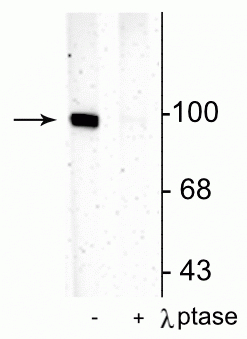Anti-GluR1-Subunit (Ser831) Antibody
Our Anti-GluR1-Subunit (Ser831) rabbit polyclonal phosphospecific primary antibody from PhosphoSolut
- SPECIFICATION
- CITATIONS
- PROTOCOLS
- BACKGROUND

| Primary Accession | P19490 |
|---|---|
| Reactivity | Bovine |
| Host | Rabbit |
| Clonality | Polyclonal |
| Isotype | IgG |
| Calculated MW | 101579 Da |
| Gene ID | 50592 |
|---|---|
| Other Names | GLUR 1 antibody, GLUR A antibody, AMPA 1 antibody, AMPA selective glutamate receptor 1 antibody, AMPA-selective glutamate receptor 1 antibody, GluA1 antibody, GLUH1 antibody, GluR K1 antibody, GluR-1 antibody, GluR-A antibody, GluR-K1 antibody, GLUR1 antibody, GLURA antibody, GluRK1 antibody, Glutamate receptor 1 antibody, Glutamate receptor ionotropic AMPA 1 antibody, Glutamate receptor ionotropic antibody, Glutamate receptor, ionotropic, AMPA 1 antibody, Gria1 antibody, GRIA1_HUMAN antibody, HBGR1 antibody, MGC133252 antibody, OTTHUMP00000160643 antibody, OTTHUMP00000165781 antibody, THUMP00000224241 antibody, OTTHUMP00000224242 antibody, OTTHUMP00000224243 antibody |
| Target/Specificity | The ion channels activated by glutamate are typically divided into two classes. Those that are sensitive to N-methyl-D-aspartate (NMDA) are designated NMDA receptors (NMDAR) while those activated by α-amino-3-hydroxy-5-methyl-4-isoxalone propionic acid (AMPA) are known as AMPA receptors (AMPAR). The AMPAR are comprised of four distinct glutamate receptor subunits designated (GluR1-4) and they play key roles in virtually all excitatory neurotransmission in the brain (Keinänen et al., 1990; Hollmann and Heinemann, 1994). The GluR1 subunit is widely expressed throughout the nervous system. GluR1 is potentiated by phosphorylation at Ser-831 which has been shown to be mediated by either PKC or CaM kinase II (McGlade-McCulloh et al., 1993; Mammen et al., 1999; Roche et al., 1996). In addition, phosphorylation of this site has been linked to synaptic plasticity as well as learning and memory (Soderling and Derkach, 2000). |
| Format | Antigen Affinity Purified from Pooled Serum |
| Storage | Maintain refrigerated at 2-8°C for up to 6 months. For long term storage store at -20°C in small aliquots to prevent freeze-thaw cycles. |
| Precautions | Anti-GluR1-Subunit (Ser831) Antibody is for research use only and not for use in diagnostic or therapeutic procedures. |
| Shipping | Blue Ice |

Thousands of laboratories across the world have published research that depended on the performance of antibodies from Abcepta to advance their research. Check out links to articles that cite our products in major peer-reviewed journals, organized by research category.
info@abcepta.com, and receive a free "I Love Antibodies" mug.
Provided below are standard protocols that you may find useful for product applications.
Background
The ion channels activated by glutamate are typically divided into two classes. Those that are sensitive to N-methyl-D-aspartate (NMDA) are designated NMDA receptors (NMDAR) while those activated by α-amino-3-hydroxy-5-methyl-4-isoxalone propionic acid (AMPA) are known as AMPA receptors (AMPAR). The AMPAR are comprised of four distinct glutamate receptor subunits designated (GluR1-4) and they play key roles in virtually all excitatory neurotransmission in the brain (Keinänen et al., 1990; Hollmann and Heinemann, 1994). The GluR1 subunit is widely expressed throughout the nervous system. GluR1 is potentiated by phosphorylation at Ser-831 which has been shown to be mediated by either PKC or CaM kinase II (McGlade-McCulloh et al., 1993; Mammen et al., 1999; Roche et al., 1996). In addition, phosphorylation of this site has been linked to synaptic plasticity as well as learning and memory (Soderling and Derkach, 2000).
If you have used an Abcepta product and would like to share how it has performed, please click on the "Submit Review" button and provide the requested information. Our staff will examine and post your review and contact you if needed.
If you have any additional inquiries please email technical services at tech@abcepta.com.













 Foundational characteristics of cancer include proliferation, angiogenesis, migration, evasion of apoptosis, and cellular immortality. Find key markers for these cellular processes and antibodies to detect them.
Foundational characteristics of cancer include proliferation, angiogenesis, migration, evasion of apoptosis, and cellular immortality. Find key markers for these cellular processes and antibodies to detect them. The SUMOplot™ Analysis Program predicts and scores sumoylation sites in your protein. SUMOylation is a post-translational modification involved in various cellular processes, such as nuclear-cytosolic transport, transcriptional regulation, apoptosis, protein stability, response to stress, and progression through the cell cycle.
The SUMOplot™ Analysis Program predicts and scores sumoylation sites in your protein. SUMOylation is a post-translational modification involved in various cellular processes, such as nuclear-cytosolic transport, transcriptional regulation, apoptosis, protein stability, response to stress, and progression through the cell cycle. The Autophagy Receptor Motif Plotter predicts and scores autophagy receptor binding sites in your protein. Identifying proteins connected to this pathway is critical to understanding the role of autophagy in physiological as well as pathological processes such as development, differentiation, neurodegenerative diseases, stress, infection, and cancer.
The Autophagy Receptor Motif Plotter predicts and scores autophagy receptor binding sites in your protein. Identifying proteins connected to this pathway is critical to understanding the role of autophagy in physiological as well as pathological processes such as development, differentiation, neurodegenerative diseases, stress, infection, and cancer.


